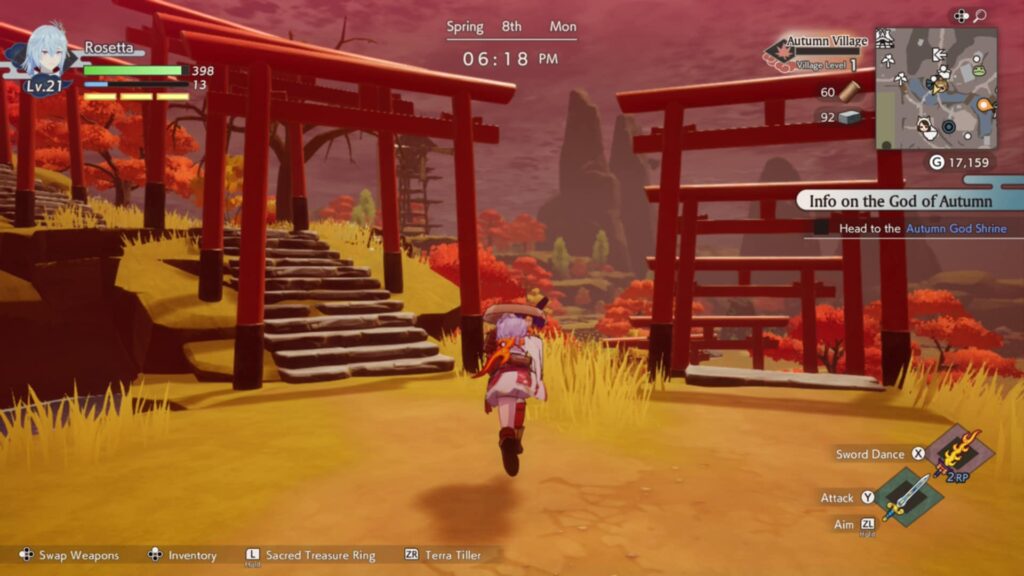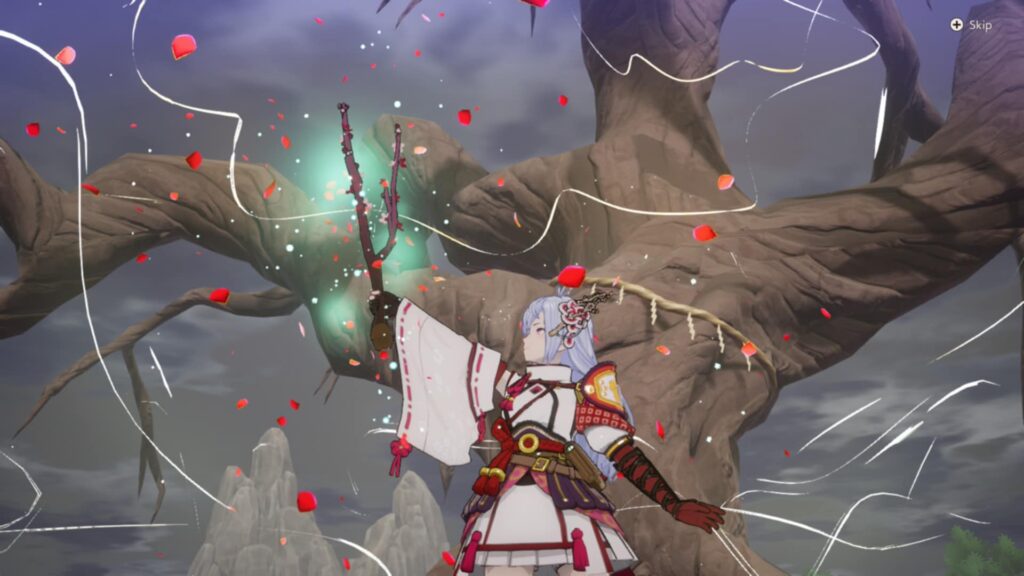Rune Factory: Guardians of Azuma is a drastic departure from everything that came before in the series. Obviously, this was expected, given the teaser for this game, alongside the Rune Factory 3 remaster announcement, promised that the next Rune Factory would be a new breed of the game. Despite this, there is no way you can anticipate that the series that became a Nintendo Handheld was going to offer such a masterful evolution of the formula. There has never been a Rune Factory that didn’t resonate with me, growing up on Harvest Moon, so this pretty much is my genre, but after Rune Factory 5 offered better graphics but a relatively safe experience, everything here feels like a risk that offers a great reward in the process.
To be fair, I’m not familiar with how the Rune Factory universe is laid out in terms of settings. Up to this point, the lead character is usually an Earthmate, though this time they are referred to as an Earth Dancer. They are the same thing, with one character, Hina, who first appeared in Rune Factory 5, using this term for you. Since Azuma is based on Asian locales and mythology, it makes sense for the difference, but in doing so, the game commits much more to a continuation of the series, making a point to embrace that this area is unique. That doesn’t stop the game from deploying its oldest trope, with the playing character waking up with no recollection of anything before, the good old amnesia trope.

One of my favorite things to see in a game where you can choose between two characters is that the unused character is still relevant to the plot. Here, depending on the base character you pick, you are partnered with a white dragon and tasked with restoring the gods of four villages, while the other character is partnered with a white dragon and serves as an antagonist that stands in your way, though with a clear relationship between both characters established there isn’t as much animosity there. As you begin your journey and help these four villages, all small but with a lot of personality, you end up becoming the chief of each of them in the first drastic departure you experience here.
While the game has seasons, these villages act as the four seasons in terms of crop, allowing you four locations to handle with no forced waiting for the right season to grow crops you need, like for tasks you receive throughout the game. These villages are also upgraded with people and buildings, alleviating the farming task completely from the player. Villagers have tasks they are given that they perform, like tending to crops and running shops, meaning that you actually never have to take on these tasks to benefit from them. Towns have operating costs, but these are pretty easy to outpace with a few stores in place, and even then, you should farm enough monster parts to be able to not remove any stress from the process of being in charge. The only complaint here is that it can be hard to set certain crops aside to do special things that only you can, such as raising their level. Checking on them early is paramount cause if you villagers get to them, your work can be set back a few days.
To compensate for the fact that money will start rolling in passively for you, the game decides to remove crafting from the player. Previously, you would place a work station to forge weapons and or decorations with a leveling skill attached to this. You could, previously, buy items from stores dedicated to this, but in most cases, those items could be crafted anyway, and the items were the most basic you could receive. This time store can be placed, allowing you to purchase new gear or peaceable items at a price, which can get pretty hefty. This also forces the recipe bread to be removed, adding one of my favorite new features to the world, hidden frog statues and shrines to the world that encourage exploration of the world to find and dance at, so where you receive recipes. Cooking is the only one of these mechanics that returns in a similar way to how it previously appeared, using fires rather than a station.

Exploring the world of a Rune Factory game has never been more rewarding, either. Each of the four towns also has a big open field to explore with collectables to find or tasks to accomplish. The game also features a set of sacred tools that you slowly unlock, which give both abilities and new ways to interact with your crops. A drum, for instance, lets you revive trees that offer lumber each day, yet don’t disappear after you chop at them, as well as helps your crops grow faster. There is also a plum branch that now acts as a way to befriend monsters, but can also be used to increase your social standing with characters. Eventually, you will get items to help you glide over gaps, or a fan to blow away smoke. This encourages the constant return to areas you may have leveled out of, just for the benefits you can find there for everything else. Even the dungeons you explore feel more well-designed than they ever have before. The only complaint here is that your character can’t swim, with water acting as a big pit to fall in, which just feels like it shouldn’t be a thing anymore.
At this point, you would be forgiven for thinking that you have seen everything there is to see. These areas make up about the size of the previous game. However, your dragon ally is also rideable, allowing you to explore the many islands that float above in the sky. These areas can range from small, with only one area to explore, to collections of islands you are gliding between. Some of these islands will even house big dungeons or special quests you can bring. These will have you flying around long into the endgame of the title, discovering new and enjoyable things. Every one of these areas is punctuated with a gorgeous soundtrack that offers a classical Japanese sound, representing the period the game so heavily plays off of.
The one tool that did not resonate with me as much as the others is the till, which is the first tool you get. This tool is how you build your village in designated areas, opening up a management tool to govern this. One of the things it adds is a pretty big stat menu to the side of the screen that stays open as long as you have the tool equipped. In addition, it creates the standard grid-based area map for placement that I have seen 100 times. Given that Stardew Valley has inspired a whole sub-genre in the sub-genre and most offer a lot of customization with no need to have an actual building mode, I wish Rune Factory had taken that cue and followed suit. This is a small price to pay for the most in-depth customization the franchise had offered up until this point.

The most welcome overhaul to the entire series is the combat, which feels much tighter and punishing. For starters, your character levels up much slower, preventing the overleveling that was very common in previous entries of the game. The removal of the skill levels also sees the game use an in-depth ability menu for each weapon and skill that you gain, an all-purpose skill for anything, and a skill for the item based on use. Placing buildings in villages, as well as these skill menus, mostly serve the point of upgrading your stats, but the abilities mixed within offer great additions to your repertoire in combat or gathering. The game’s flash dodge, triggered when you land a perfect dodge and stops time, is more viable than it ever was previously, since most enemies around your level can punish you when you get surrounded or just eat a few attacks. Mixed within these are going to be more powerful enemies that do not go down without a fight, forcing you to fight them with everything you have.
The party system also got an overhaul, now having an actual menu rather than needing to talk to the person to recruit them. This is one of many streamlined overhauls that work wonders in making the game more fun and approachable. You will also want to form a party early since the game is designed around that for combat, whereas it was easy to get away without one before. Never is this more apparent than in boss battles when you deal minimal damage, take maximum, and need to constantly dodge right to build up the enemy stagger gauge for an opening to deal massive damage. Having characters to distract and create that opening, you need to make progress on them. The boss battles were so fun, the fact that you can retry them in any area you fought them is now a major plus, even if that isn’t a new feature.
Like with all cozy sims, interpersonal relationships return in a big way in Rune Factory: Guardians of Azuma. There is a mix of romanceable characters and friends, and the game doesn’t limit you based on gender when it comes to romancing a character. There are a lot of fetch quest requests that you can partake in as the task board returns, and individual characters might ask for items, but the character quests that appear manage to become incredibly engaging. As you build your relationship, gauge new narrative moments and story beats that will open up that offer a lot of narrative for side characters and the world. Several side quests that offer more than just fetching appear as well, which again draw you in as you can get lost in exploring the side content, which is extremely beneficial for a game with so much going on off the beaten path. You WANT to get lost in Azuma, which felt brand new to me.

Verdict
Rune Factory 5 had a tumultuous development cycle in which there were questions of whether it might even see release. To imagine that so shortly after it was released, the developers committed to a new title that would be a drastic departure, and then actually getting the experience of Rune Factory: Guardians of Azuma is absolutely mind-blowing. There are elements that didn’t work for me as well as I was hoping, and others I spent hours debating if I didn’t like them or just felt weird that they were changed. But, here is the thing, at no point is this experience not an improvement over everything that came before. This is the best Rune Factory has ever been and a game that can stand against the best of the genre, not just its own series. If there is one Nintendo Switch 2 game I would recommend, this is it.
Remember to follow us on Twitter, Facebook, and Bluesky to keep up to date on everything we have going on!
Review For Nintendo Switch 2, also available for Nintendo Switch and PC
Developer: Marvelous Inc.
Publisher: Marvelous USA, XSEED Games
Release Date: June 5, 2025
Good:
+Great Narrative and Side Stories
+Fun Combat Overhaul
+Engaging World To Explore
+Multitude of Changed Elements To The Series
Bad:
-Management Menu
-Some Management Elements
-
Rune Factory: Guardians of Azuma